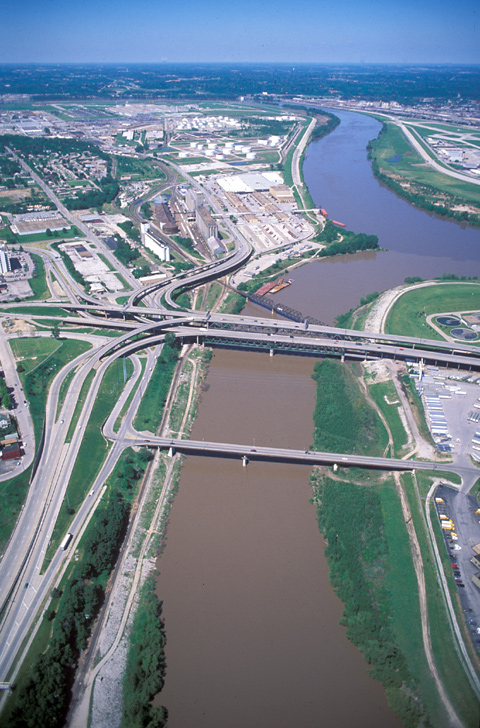Kansas River
View northeast down the Kansas;
the Missouri flows from left to right
© 2000 Airphoto—Jim Wark.
Today, the Kansas River (bottom)—also known as the Kaw—is closer to its probable 1804 location than the Missouri River, which at that time may have met it at nearly a right angle somewhere near the petroleum depot at upper center. In the photo, Kansas City, Kansas, is to the left and lower right of the two rivers; Kansas City, Missouri, founded in 1821, is at upper right.
The expedition’s campsite from 26 June 1804 to 28 June 1804 was near the wooded point that protrudes at the confluence. They knew that the Kansas River—named for the resident Indian tribe—was important, but they would not be able to explore it to the extent they would have liked. Its full length and character were still conjectural. “To Describe the most probable of the various accounts of this great river of the Kansas,” wrote Clark, “would be too lengthy & uncertain to insert here.”
Still, they decided to stay for several days to “recruit”—which to them meant rest—and at least get acquainted with this part of it. After building a defensive line of logs and brush against the possibility of an Indian attack during the night—one of the engagés had indicated the area natives could be unfriendly—they proceeded to the business of discovery, determining the latitude of the place, recording the contours of the floodplain and uplands, and measuring the rivers’ widths, flows, temperatures, and silt content. Clark found only one fault: “The waters of the Kansas is verry disagreeably tasted to me.”
The men noticed flocks of brilliant-hued Carolina parakeets (Conuropsis carolinensis) in this neighborhood. Although common at that time throughout the southeast and in the wooded river bottoms of the plains, this sole North American species of parrot was eventually doomed to extinction. Tending, like the passenger pigeon, to feed in hordes upon orchards and grain fields, it was regarded as a pest by farmers. On the other hand, its sheer beauty was part of its doom. It was trapped for the caged-bird market. Worse, it was extremely attractive to the millinery trade, which paid good prices for its plumage, and its sociable habits made it easy for hunters to harvest in profitable numbers. By 1920 the species was gone for good.
See also The Kansas River.
From Discovering Lewis & Clark from the Air
Photography by Jim Wark
Text by Joseph Mussulman
Reproduced by permission of Mountain Press

